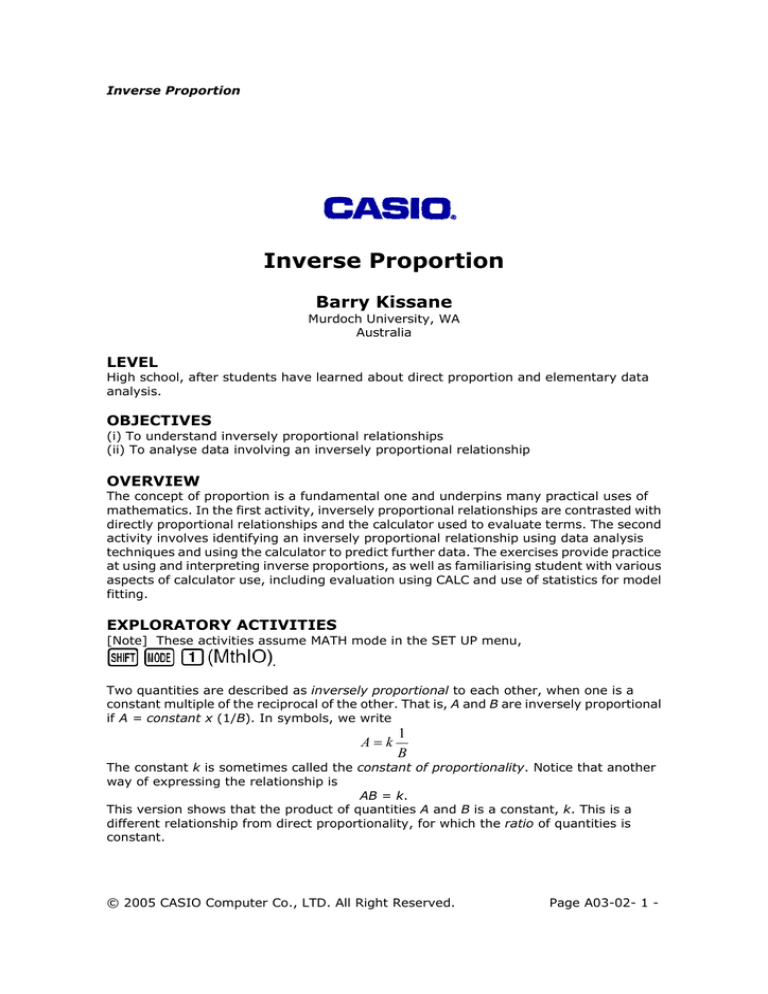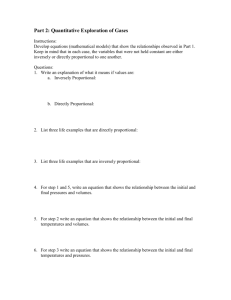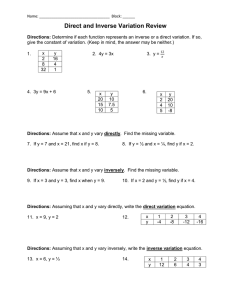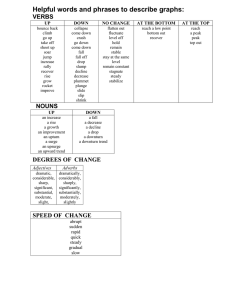
Inverse Proportion
Inverse Proportion
Barry Kissane
Murdoch University, WA
Australia
LEVEL
High school, after students have learned about direct proportion and elementary data
analysis.
OBJECTIVES
(i) To understand inversely proportional relationships
(ii) To analyse data involving an inversely proportional relationship
OVERVIEW
The concept of proportion is a fundamental one and underpins many practical uses of
mathematics. In the first activity, inversely proportional relationships are contrasted with
directly proportional relationships and the calculator used to evaluate terms. The second
activity involves identifying an inversely proportional relationship using data analysis
techniques and using the calculator to predict further data. The exercises provide practice
at using and interpreting inverse proportions, as well as familiarising student with various
aspects of calculator use, including evaluation using CALC and use of statistics for model
fitting.
EXPLORATORY ACTIVITIES
[Note] These activities assume MATH mode in the SET UP menu,
.
Two quantities are described as inversely proportional to each other, when one is a
constant multiple of the reciprocal of the other. That is, A and B are inversely proportional
if A = constant x (1/B). In symbols, we write
A=k
1
B
The constant k is sometimes called the constant of proportionality. Notice that another
way of expressing the relationship is
AB = k.
This version shows that the product of quantities A and B is a constant, k. This is a
different relationship from direct proportionality, for which the ratio of quantities is
constant.
© 2005 CASIO Computer Co., LTD. All Right Reserved.
Page A03-02- 1 -
Inverse Proportion
Activity 1: Dimensions of a rectangle
A common example of quantities that are inversely proportional occurs with rectangles of
the same area. Remember that the area of a rectangle can be found by multiplying the
lengths of the sides.
A
B
Area = AB
Consider rectangles with areas of 36 square metres.
If you know the length of one of the sides, A, you can determine the length of the other
side, B. For example, if A = 12m, B = 3m. Similarly, if A = 8m, B = 4.5m. Complete the
table below:
A
B
12
3
8
4.5
4
36
2
One way of expressing this relationship to show the proportionality is A = 36/B, with A
referring to one dimension of the rectangle and B referring to the other dimension.
Another way of expressing the relationship is A = 36B-1.
Further values of the two variables can be generated on the calculator using one of these
formulas. Here is how to enter the first one, A = 36/B.
[Operations]
• Select Mode 1:COMP
• Enter formula
Then values of A can be generated from any values of B, using the CALC command.
[Operations]
• Enter CALC
• Enter B value
• Enter CALC
• Enter new B value
etc.
Unlike the case for direct proportion, inverse proportional relationships can be written in
either direction, and have the same constant of proportionality. In this case, as well as A
© 2005 CASIO Computer Co., LTD. All Right Reserved.
Page A03-02- 2 -
Inverse Proportion
= 36/B or A = 36B-1, the relationship can be expressed as B = 36/A or B = 36A-1. Check
this for yourself by constructing and using the inverse proportional formula in the
opposite way to the one above. The steps are shown below.
[Operations]
• Select Mode 1:COMP
• Enter formula
Now, values of B can be generated from any values of A, using the CALC command.
[Operations]
• Enter CALC
• Enter A value
• Enter CALC
• Enter new A value
etc.
Notice the meaning of ‘inverse’: inverse proportional relationships are unlike directly
proportional relationships, for which an increase in one variable leads to an increase in
the other variable. For example, recall the conversions from one unit to another, such as
from miles to kilometres. A longer distance in miles leads to a longer distance in
kilometres.
With inversely proportional relationships, the two variables are related in an opposite way.
In the case of the rectangle, a longer value of A leads to a shorter value of B and vice
versa. In other words, the greater the length, the shorter the width. Check this with the
table and the formulas above.
Here is another example involving inverse proportion: a number of workers must weed a
large rice field. If ten workers are involved, it will take them six days. How long will it take
if there are twelve workers instead of ten? Alternatively, how long would the weeding
take if there were only four workers, instead of ten? [Of course, we assume that all
workers are equally effective and that all days are the same.]
The two quantities,
A = number of workers
B = number of days
Are inversely proportional: If there are less workers, the weeding will take more time. If
there are twice as many workers, the weeding will take only half as long.
So, AB = constant.
The constant is equal to 10 x 6 = 60, since we know that ten workers will need six days
to do the job. So the relationship is
AB = 60 or A = 60/B.
© 2005 CASIO Computer Co., LTD. All Right Reserved.
Page A03-02- 3 -
Inverse Proportion
Once the relationship is known, we can make a formula as before, and calculate any
values of one variable from values of the other variable, as follows:
[Operations]
• Select Mode 1:COMP
• Enter formula
Now, values of A can be generated from any values of B, using the CALC command.
[Operations]
• Enter CALC
• Enter B value
• Enter CALC
• Enter new B value
etc.
So, to answer the questions asked above, twelve workers would need only five days,
while four workers would require 15 days to complete the weeding.
Activity 2: Analysing data
Recognising the form of a relationship is useful for understanding it. The Casio fx-991ES
allows you to analyse paired data to determine the relationship, if any, between the two
variables. In this activity, we will see how to do this. Consider the following data for
variables x and y:
x
y
0.5
12
1
7
2
4.5
4
3.25
5
3
10
2.5
It seems plausible that x and y are inversely proportional to each other, since one gets
larger as the other gets smaller. However, on closer inspection, this is not the case, since
the value of xy is not a constant. It may be a negative linear or negative exponential
relationship or some other form of relationship in which y decreases as x increases. The
calculator can be used to explore these sorts of possibilities,
To use the calculator to explore a relationship we need to enter the data into the STAT
area. We will start by assuming that the relationship may be a linear one, but can check
this assumption later.
[Operations]
• Select Mode 3:STAT
• Select 2: A + BX
The calculator now shows two columns for x and y data. Enter the x data first.
© 2005 CASIO Computer Co., LTD. All Right Reserved.
Page A03-02- 4 -
Inverse Proportion
[Operations]
• Enter x values
etc
• Change columns
• Enter y values
etc
• Finish data entry
If you make an error when entering data, use the
re-type the data.
key to delete the current row, and
When finished entering the data as above, the calculator display will be blank, and will
show STAT to indicate that it is still in STAT mode. You should check your data carefully
before proceeding with any analysis, as it is easy to make typing errors and dangerous to
proceed until you are sure that you haven’t done this. To review the data, follow the
operations below:
[Operations]
• Enter STAT menu
• Select 2: Data
• Check values
etc
• When finished
An incorrect value should be highlighted with the cursor; then type the correct value to
replace it and press the equals key to confirm.
To check the suitability of a linear model (y = A + Bx) model, access the Regression menu
(Reg) and choose the correlation coefficient (r). If the relationship is linear, the value of
the correlation coefficient should be close to r = 1 or r = -1.
[Operations]
• Enter STAT menu
• Select 7: Reg
• Select 3: r
• Display value
• When finished
The r value of -0.720 suggests that a linear model is not appropriate in this case. (An r
value closer to -1 would have been expected if the relationship were linear or very close
to linear.)
To check instead the suitability of a model exponential model (y = ABx) model, change
the Type to exponential and then check the r value as shown below.
© 2005 CASIO Computer Co., LTD. All Right Reserved.
Page A03-02- 5 -
Inverse Proportion
[Operations]
• Enter STAT menu
• Select 1: Type
• Select 6: A.B^X
• Exit from data
• Enter STAT menu
• Select 7: Reg
• Display r
The r value of -0.828 suggests that an exponential model is not appropriate in this case.
(An r value closer to -1 or 1 would have been expected if the relationship were negative
exponential or very close to it.)
To check the suitability of a model involving inverse proportion (y = A + B(1/x)), change
the Type again and then check the r value as shown below.
[Operations]
• Enter STAT menu
• Select 1: Type
• Select 8: 1/X
• Exit from data
• Enter STAT menu
• Select 7: Reg
• Display: r
The r value of 1 makes it clear that the relationship is of the form y = A + B/x. To find the
actual values of A and B, follow the operations below.
[Operations]
• Enter STAT menu
• Select 7: Reg
• Display 1: A
• Enter STAT menu
• Select 7: Reg
• Display 2: B
This analysis shows that the relationship is y = 2 + 5/x. Although this is not inversely
© 2005 CASIO Computer Co., LTD. All Right Reserved.
Page A03-02- 6 -
Inverse Proportion
proportional, a slight rearrangement to y - 2 = 5/x makes it clear that the two variables
y – 2 and x are inversely proportional to each other.
Check in the table of values below that this is the case.
x
y
y-2
0.5
12
10
1
7
5
2
4.5
2.5
4
3.25
1.25
5
3
1
10
2.5
0.5
Notice that, in each column of the table, the value of x(y – 2) = 5, which is the constant
of proportionality in this case.
EXERCISES
The purpose of the exercises is to give you an opportunity to do some independent work,
to develop fluency with calculator use and to learn more about inversely proportional
relationships.
Exercise 1
A number of people shared a lottery prize equally. Explain why each person’s share is
inversely proportional to the number of people.
Exercise 2
If it takes a team of four workers 15 working days to build a boat, how long would the job
take if an extra six workers were used?
Exercise 3
Which of the following three tables, if any, show an inversely proportional relationship
between A and B? Give reasons for your choices.
A
B
2
6
4
12
6
18
8
24
A
B
2
5
4
7
7
10
11
14
A
B
6
2
8
1.5
12
1
24
0.5
Exercise 4
Consider the following data.
x
y
1
11
2
8
3
7
4
6.5
5
6.2
6
6
There is a relationship between x and y involving inverse proportion. Use the calculator to
identify the relationship. What is the y value associated with x = 8?
© 2005 CASIO Computer Co., LTD. All Right Reserved.
Page A03-02- 7 -
Inverse Proportion
SOLUTIONS
Exercise 1
The product of the number of people and the amount of each prize is a constant (and
equal to the lottery prize to be shared). So the relationship is inversely proportional.
Exercise 2
If N stands for the number of workers and D stands for the number of days worked, then
ND = constant. Since we know N = 4 when D = 15, the constant is 4 x 15 = 60. So ND =
60. If there were an extra six workers, N = 4 + 6 = 10, and so D = 60/10 = 6. So it would
take six days to build the boat.
Exercise 3
Only the third table shows an inversely proportional relationship, with the product AB
equal to a constant (12) for all pairs of values. The first table shows a directly
proportional relationship, B = 3A. The second table shows A = B – 3, which is not a
proportional relationship.
Exercise 4
The relationship is y = 5 + 6/x.
That is, y – 5 is inversely proportional to x, which can be expressed as x(y – 5) = 6.
When x = 8, y = 5 + 6/8 = 5.75.
© 2005 CASIO Computer Co., LTD. All Right Reserved.
Page A03-02- 8 -





